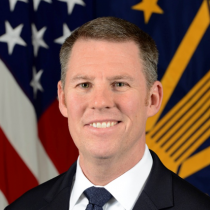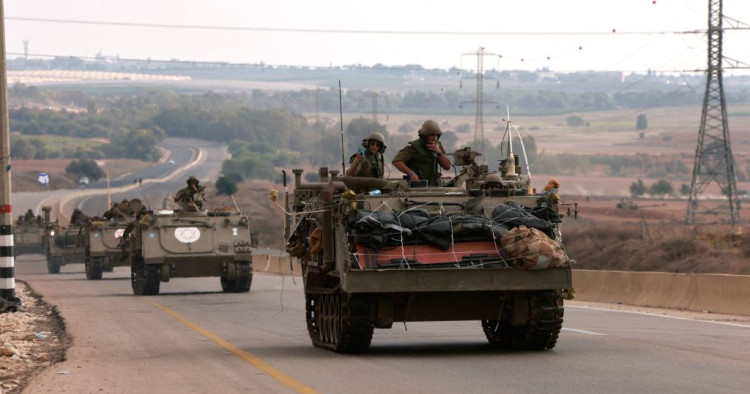Contents:
- Israel-Hamas war: Conflict scenarios, risks of regional escalation, and US diplomacy
- The Biden administration moves to prevent a wider Middle East war and address growing human security challenges
- Before Israel launches a Gaza ground operation, there is an opportunity for a humanitarian captive swap
- Gazans’ intolerable reality as the war fuels a humanitarian crisis
- Gaza conflict lays bare the weaknesses and inadequacies of the Palestinian Authority leadership
- Hezbollah’s calculations on opening a second front against Israel
- Israel’s and the U.S.’s decision points in the Israel-Hamas war
- Militarily powerful but crisis-wracked Pakistan is drawn toward Israel-Gaza war
Israel-Hamas war: Conflict scenarios, risks of regional escalation, and US diplomacy
Paul Salem
President and CEO

-
There are two potential scenarios for Israel’s ground incursion: First, a full-scale invasion and occupation of the entire Gaza Strip and an attempt to fully root out Hamas, and second, something that would resemble previous Israel invasions of Gaza but on a much larger scale.
-
In either scenario the loss of life on all sides would be enormous, the end state would remain unstable and fraught, and there would be a real risk of the war spreading to other arenas; so for the immediate future, attention must be focused on protecting civilians in Gaza as much as possible from the next phase of the conflict.
Nine days after the Hamas attack inside Israel, the Israel Defense Forces (IDF) are massing troops for a large-scale ground incursion into Gaza. For now, the outlines and endgame of Israel’s military action are not entirely clear. Meanwhile, escalation is rising along the Israel-Lebanon border, and U.S. Secretary of State Antony Blinken is crisscrossing the Middle East communicating both deterrence and diplomacy.
One can describe two scenarios for Israel’s invasion of the Gaza Strip. The first would hew closely to its declared intention of destroying Hamas; this would presumably entail a full-scale invasion and occupation of the entire Gaza Strip and an attempt to fully root out Hamas. This would not be easy, and Hamas is likely prepared for it. And while civilians have little place to run and hide, Hamas fighters have readymade tunnels and escape routes to use. Such a full-scale invasion would likely include high Israeli casualties as well as very high Palestinian civilian casualties. How Israeli public opinion would measure the cost and benefit of losing many more Israeli lives, and how world and regional opinion would pressure Israel to limit the loss of Palestinian lives, would have to be factored in. And if the invasion succeeded, the main question would be what to do afterward. An extended occupation of hostile territory is unsustainable, and the idea that the Palestinian Authority (PA), or some third power, would agree to take control of Gaza on the heels of an Israeli invasion is unrealistic.
The second scenario would resemble previous Israel invasions of Gaza but on a much larger scale. The Israeli bombardment and ground incursion would proceed. As the human toll mounted and Israel built a wider “buffer zone” for itself inside Gaza, and if it felt that Hamas had been degraded and chastened “enough,” the situation could pivot toward looking for a ceasefire and negotiation. Israel might conclude that fully and permanently rooting out Hamas is not a realistic or achievable goal, or that it’s too costly. Also, Israel — and the U.S. — have to contend with the fact that Hamas holds around 200 hostages that they want back.
In either scenario the loss of life on all sides would be enormous and the end state would remain unstable and fraught. In either scenario, there is a real risk of the war spreading to other arenas. Tension and conflict have already spread to parts of the West Bank, where violence between Israeli settlers and Palestinians has resulted in the killing of over 50 Palestinians. Tension in mixed communities inside Israel is also running high.
But the real risk is of Iran encouraging Hezbollah to open a second front across the Lebanese-Israeli — and Syrian-Israeli — border. Exchange of fire across the Lebanon-Israeli border has already exceeded anything seen since the war of 2006. Iran and Hezbollah don’t want to lose Hamas as a strategic asset. If Hamas is able to survive the Israeli onslaught and maybe fight the IDF to a bloody standstill in Gaza, then perhaps Hezbollah would not up the ante to a full-scale second front; however, if Iran and Hezbollah observe that Hamas is at risk of going under, then opening a major second front may become a reality.
As he crisscrosses the region, U.S. Secretary of State Blinken has a complex challenge on his hands. Moving two carrier strike groups into the eastern Mediterranean is a strong show of support for Israel and aims to communicate a message of deterrence to Iran and Hezbollah. The challenge will be to communicate that the U.S. has the will to follow through — clarifying what its “red lines” are in this crisis, and what it might do credibly if they are crossed. Blinken has also been busy trying to square the circle of standing fully in support of a strong Israeli military response to the Hamas attacks, while at the same time being mindful of the humanitarian costs of the war in Gaza, the violations of international law that are likely being committed, and the need to care for more than 2 million civilians trapped in a locked Gaza that currently has no water or supplies of fuel and medicine incoming.
For the immediate future, attention must be focused on protecting civilians in Gaza as much as possible from the next phase of the Israel-Hamas war. In the medium term, the regional and international community must help figure out what the new status quo will be in Gaza, how to rebuild stability and security, and how to revive life for its 2 million inhabitants. In the longer term, efforts must be redoubled to revive a realistic diplomatic process between Israelis — maybe with a new Israeli government after this war — and the PA.
This piece is an excerpt from a longer article.
Follow on Twitter: @paul_salem
The Biden administration moves to prevent a wider Middle East war and address growing human security challenges
Brian Katulis
Vice President of Policy

-
U.S. Secretary of State Antony Blinken continues crisis shuttle diplomacy aimed at aligning U.S. partners to prepare for the fallout of the Israel-Hamas war and preventing a wider regional escalation.
-
The Biden administration is raising concerns about the human security situation in Gaza while trying to secure the release of hostages and create safe passage for Palestinian civilians.
With the crisis in Israel and Gaza growing, the United States further stepped up its engagement across the Middle East over the past week, representing the Biden administration’s deepest regional involvement since it came into office in 2021. The primary objective of this intensified diplomatic outreach and military deployments was to prevent a wider regional war as Israel mounts its response to the Oct. 7 terrorist attacks and armed incursions by Hamas. The United States sent its top diplomat, Secretary of State Antony Blinken, on a multi-country shuttle diplomacy tour. And it deployed a second aircraft carrier strike group to the region as a message of deterrence against Lebanese Hezbollah, Iran, and any other actors threatening to widen the war.
The Biden administration continues to express support for Israel as the latter conducts airstrikes in the heavily populated Gaza Strip. At the same time, Israel’s threat of a ground invasion looms large but has yet to begin. Over the weekend, Israel issued calls, via air-dropped leaflets as well as on social media, for Gaza residents to move south — a call criticized by United Nations officials. In turn, Hamas called on Palestinians to stay in their homes.
Arriving to the region on Wednesday, Secretary of State Blinken visited seven different countries, including Israel, Jordan, and Saudi Arabia two times, in an intense six-day surge of crisis diplomacy. His aim has been to try to get U.S. partners on the same page in reaction to what’s already happened and to prepare for what’s likely to come. Blinken finds a regional landscape where close U.S. partners have divergent views on a range of issues, from how to deal with Hamas to how to respond to Israel’s military operations. President Joe Biden backed Israel’s goal to eliminate Hamas, even as some close U.S. partners in the region periodically meet with the militant group’s leadership. Several Arab countries, like Egypt and Saudi Arabia, have also called for a de-escalation between Israel and Hamas, something the Biden administration has so far avoided. Building a coherent and unified multilateral response will prove particularly challenging: 2023 is not 1991, when a regional and international coalition against Iraq’s invasion of Kuwait was comparatively easier to build than may prove possible in this more complicated situation still unfolding in the Middle East.
In the fog of the early days of this war, the Biden administration has engaged in crisis diplomacy aimed at trying to secure the release of hostages while also addressing the deteriorating humanitarian situation in the Gaza Strip. Also over the weekend, the Biden team appointed seasoned U.S. diplomat David Satterfield as the special envoy for Middle East humanitarian issues, an indication of how challenging the human security dimension is already becoming and how it could worsen substantially in the coming weeks.
The Middle East is now a volatile maelstrom of uncertainty, and the United States continues to step up its engagement there in ways that will likely define the future of the country’s relations with the region for years to come.
Follow on Twitter: @Katulis
Before Israel launches a Gaza ground operation, there is an opportunity for a humanitarian captive swap
Nimrod Goren
Senior Fellow for Israeli Affairs

-
Just as everything seemed set for an Israeli ground operation in Gaza, international efforts on humanitarian steps are taking center stage.
-
The expectation in Israel is that this humanitarian-focused phase must also include the release of Israeli captives in Gaza, primarily women, children, and the elderly.
More than a week into the Israel-Hamas war, many expected Israeli ground forces to already be operating in the Gaza Strip. After several days of airstrikes, military preparations, and consolidating American support, everything seemed to be set for the next phase in Israel’s response to the brutal Oct. 7 Hamas terror attack inside Israel.
While a ground operation is still likely, perhaps soon, it has been postponed for a while to address humanitarian needs. International calls on Israel to abide by humanitarian law, coupled with condemnations of Hamas’ actions on the one hand and regional shuttle diplomacy by U.S. Secretary of State Antony Blinken on the other, created a narrow window of opportunity to mitigate human suffering and prepare for what might come next.
Israel has resumed water supply to the southern Gaza Strip. Safe passage for foreign nationals from Gaza to Egypt has been negotiated, but not yet implemented; and the same is true for a humanitarian corridor from Egypt to Gaza that would enable the flow of some basic supplies (including those arriving from Turkey, via the al-Arish airport). In parallel, Egypt is also preparing to deal with a possible refugee flow from Gaza.
While these measures fall far short of addressing the full range of needs created by the war, they reflect that the human dimension has not gone unnoticed. A key component still missing from this humanitarian package is the release of nearly 200 Israeli captives held in Gaza by Hamas (including dual nationals), among them women, children, and the elderly. Their fate is currently dominating the Israeli discourse.
As time goes by, it will become increasingly difficult to ensure their safe return, especially as some have been injured by Hamas and require urgent medical treatment. Therefore, an immediate swap is seen by many in Israel as a prerequisite for any Israeli humanitarian step towards the Palestinians in Gaza, including the above-mentioned ones. Should President Joe Biden actually visit Israel this week, as he is reportedly considering, it would be an appropriate opportunity to seal an agreement on the current humanitarian package.
Israeli civil society is mobilizing to advance this. Non-governmental organizations are providing support to the families of the hostages, leading awareness-raising initiatives, and calling on the international community to take action. For example, several international campaigns have been launched, including letters sent by the National Council for the Child to states and organizations, urging them to “exert all diplomatic efforts to ensure the safety and well-being of the child hostages, and their prompt and safe return to Israel.”
Key international actors (such as the United States, United Nations, and European Union) are already supporting this cause, while calling on all sides to uphold international humanitarian law. So too is Knesset Member Mansour Abbas, leader of Israel’s Islamist Ra’am party. Stepping up efforts in this regard will help to make the most of the current limited humanitarian window of opportunity — for the benefit of both Israelis and Palestinians alike — before it again closes for a time once things escalate further.
Follow on Twitter: @GorenNimrod
Gazans’ intolerable reality as the war fuels a humanitarian crisis
Carol Daniel Kasbari
Non-Resident Scholar

-
The Israeli Air Force’s retaliation against Hamas’ attack has resulted in significant civilian casualties in Gaza, with over 2,600 Palestinians killed, 64,283 homes damaged, and reports of the use of white phosphorus munitions.
-
Relief supplies are landing in Egypt’s Sinai as the U.S. seeks to establish humanitarian corridors, but no agreement has yet been reached while Israel preps for a potential Gaza invasion.
On Oct. 7, Hamas launched an unprecedented and brutal attack against Israel, resulting in the tragic death of at least 1,300 Israelis. In response, the Israeli Air Force (IAF) has conducted numerous sorties over Gaza, dropping at least 6,000 bombs as of Saturday. The conflict has claimed the lives of over 2,600 Palestinians in Gaza and injured 9,200 as of Oct. 15, the majority of whom have been civilians, including women, children, and entire families. Given that nearly 42.5% of Gaza’s population is under 14, children have tragically become the primary victims, with 724 losing their lives in just one week.
The aftermath of these operations has been materially devastating as well, with 64,283 residential units either destroyed or severely damaged. In addition, a human rights monitoring group reported that Israel’s military has recently deployed white phosphorus munitions in Gaza. These weapons, known to cause severe burns, are deemed especially hazardous for civilians because of their indiscriminate effects.
A number of Israeli officials have used inflammatory language to justify these military actions, suggesting that Gaza’s entire population — which includes over 2.2 million people, half of them children — should face collective punishment. A staggering 1.1 million Palestinians have been advised to relocate to the southern part of the enclave. Philippe Lazzarini, the head of the United Nations Relief and Works Agency for Palestine Refugees in the Near East (UNRWA), has expressed grave concerns over this directive, highlighting that over 423,000 individuals have already been internally displaced, with 270,000 seeking refuge in UNRWA shelters.
The southward migration presents its own set of challenges. Facilities to accommodate such a massive influx are non-existent. UNWRA’s schools, currently sheltering 270,274 Palestinians across 102 sites, are at full capacity. The region’s infrastructure is crumbling, electricity is scarce, hospitals are nearing collapse, and essential medicine is running out. The bombing of the water treatment plant has raised fears of waterborne diseases. A young woman from Gaza poignantly described the harrowing situation, speaking of the omnipresent smell of death, sleepless nights filled with the sounds of explosions and cries, and the heart-wrenching loss of loved ones. Humanitarian reserves are depleting rapidly.
While Israeli Prime Minister Benjamin Netanyahu’s office has claimed that water was restored to southern Gaza, the director of the Palestinian Water Authority contradicted this, citing the lack of electricity to pump water. The tiny but densely populated Palestinian coastal region is grappling with severe shortages, even of body bags. In some instances, ice cream truck refrigerators are being used to store bodies, while others are buried in mass graves. The region’s internet connectivity, a vital link to the outside world, is dwindling. The World Food Programme has warned that food stocks are running out. Hospitals are out of painkillers, and many residents are facing severe dehydration, according to Médecins sans Frontières (Doctors Without Borders).
U.N. agencies, committed to supporting Gaza’s population, have shifted operations to the south to ensure uninterrupted humanitarian aid. The U.N. World Health Organization (WHO) has also voiced its concerns, with spokesperson Tarik Jasarevic describing Israel’s relocation order as a potential “death sentence” for many.
Egypt is facing mounting pressure to establish a humanitarian corridor. However, concerns about refugee camps in Lebanon and Jordan, housing over 1 million and 3 million refugees, respectively, have made the Egyptian authorities hesitant, fearing this might trigger a new wave of permanent Palestinian refugees in Egypt, reminiscent of the 1948 Nakba. Furthermore, both Egypt and Jordan are seeking assurances that aid convoys will not be targeted.
Relief supplies for Gaza have been landing on Egypt’s Sinai Peninsula via aid flights, as diplomatic channels work tirelessly to establish humanitarian corridors into the beleaguered Palestinian territory. During his regional tour over this past week, U.S. Secretary of State Antony Blinken expressed America’s intent to set up aid routes and secure zones. However, by Saturday evening, a consensus on delivering aid to the 2 million Palestinians facing bombardment remained elusive, while Israel prepared for a potential Gaza invasion.
An increasing number of countries, international rights groups, and organizations are pressing Israel to follow international laws of war, highlighting the importance of safeguarding civilians and not targeting hospitals, schools, and clinics in the densely populated Gaza Strip. It is imperative for global leaders to champion the defense of the rules-based international order and adherence to human rights and accountability to prevent further atrocities.
Follow on Twitter: @CarolDkas
Gaza conflict lays bare the weaknesses and inadequacies of the Palestinian Authority leadership
Anas Iqtait
Non-Resident Scholar

-
The ongoing conflict in Gaza starkly highlighted the administrative failures and diplomatic feebleness of the Palestinian Authority (PA), both preceding and during the war.
-
The PA’s leadership is profoundly infuriated by Hamas’ actions, which initiated the conflict, acutely aware of the volatile convergence of security, political, and economic crises facing the PA in the West Bank.
The ongoing conflict in Gaza starkly highlighted the failures of the Palestinian Authority (PA), both preceding and during the war. As Gaza faces an escalating humanitarian crisis — with Israeli efforts to force the Palestinian population south toward the Sinai and bombardments resulting in over 2,670 casualties, including 600 children — the conspicuous inaction of the PA has intensified its perceived irrelevance. The PA’s leadership is profoundly infuriated by Hamas’ actions. PA officials believe that they had been leveraging Saudi Arabia’s normalization discussions with Israel to rejuvenate their waning relevance. Furthermore, there’s a prevailing sentiment within the PA that Hamas’ actions were strategically designed to undermine and embarrass them. Consequently, the PA finds itself sidelined by Hamas, especially in light of the resurgence of regional diplomatic efforts.
Hamas initiated the conflict, acutely aware of the volatile convergence of security, political, and economic crises facing the PA in the West Bank. The year 2023 had already been marred as the deadliest for Palestinians in the West Bank since the Second Intifada, marked by unchecked Israeli settler violence, rampant property demolitions, and the forceful eviction of Palestinians from extensive areas of this territory. An existential financial crisis has further amplified the PA’s challenges, evidenced by its inability to pay public servants and the accumulation of billions of dollars in debt to the private sector. With Israel enforcing a complete lockdown on the West Bank since the war’s inception, the PA is facing bankruptcy: halted economic activities and plummeting tax revenues from imports — their primary revenue source — intensify the crisis. Internally, the PA’s cohesion is fraying, with evident rifts between key figures and President Mahmoud Abbas striving to maintain a semblance of control as ambitious Fatah leaders jockey for dominance and control over shrinking PA resources.
The PA’s tepid response to the situation in Gaza is likely to draw the broader Palestinian public’s frustration. Palestinians had expected decisive support, especially during widespread protests across the West Bank this week; but Abbas has yet to address them. His pronounced domestic absence, combined with his lack of presence in critical regional discussions, further diminishes his leadership. The PA’s future course of action is uncertain. However, what’s unmistakably clear is the void in the PA vision for the Palestinians. Its unpreparedness for the crisis, despite widespread predictions of a major explosion, underscores the PA’s inadequacy.
Follow on Twitter: @AnasIqtait
Hezbollah’s calculations on opening a second front against Israel
Randa Slim
Senior Fellow and Director of Conflict Resolution and Track II Dialogues Program

-
Israel’s objective to physically expel Hamas from Gaza is, in itself, unprecedented and dramatically alters Hezbollah’s own calculations regarding entering the war.
-
In entertaining whether to act upon its red line and open up a second front against Israel, Hezbollah will consider whether Israel can succeed in wiping out Hamas, how bloody its Gaza operation is, whether and how deeply the U.S. intervenes, and how a multi-front regional war would be seen by Arab public opinion.
Since the Hamas attack on Oct. 7, regional and extra-regional actors have been working to prevent an expansion of the conflict beyond the Gaza-Israel theater, focusing particularly on the Lebanese-Israeli border. The United States sent two aircraft carriers to the eastern Mediterranean primarily as a deterrence message to Iran and Hezbollah.
A decision by Hezbollah to enter the ongoing war would open a second front and bring into the fight their large arsenal of rockets and precision-guided missiles capable of hitting critical Israeli infrastructure. It would also bring destruction to Lebanon while the country reels from a severe economic crisis.
The Lebanese caretaker prime minister, Najib Mikati, has already announced he has not been given guarantees by Hezbollah leadership that they will not engage in this fight once the Israeli ground invasion of Gaza starts.
Since 2006, a mutual understanding of the rules of the game has been in place between Hezbollah and Israel to govern their conflict. When these rules were violated, a limited tit-for-tat escalation followed, but soon thereafter, indirect negotiations mediated by the United Nations Interim Force in Lebanon (UNIFIL) led to a restoration of the status quo ante.
Since Oct. 7, we have been witnessing a slow and steady degradation of these rules. Hezbollah’s spokesperson, Rana Sahili, notably referred to the increased intensity in cross-border fire exchanges — which led to the death of three Hezbollah militants, a Lebanese journalist, and two civilians by Israeli shelling and the death of an Israeli soldier in a Hezbollah cross-border missile attack — as “only skirmishes” and representing a “warning” to Israel. A statement issued by the militant group, following Hezbollah Secretary-General Hassan Nasrallah’s meeting with Iranian Foreign Minister Hossein Amir Abdollahian in Beirut, stressed “the responsibilities of each person and the positions to be taken in the face of these historic events and these dangerous developments.” Last Friday, Hezbollah’s Deputy Secretary-General Naim Qassem said the attempts at outreach by “major countries, Arab countries, and envoys from the United Nations, directly and indirectly, asking us not to interfere in the battle, will not affect us.”
We have entered uncharted territory primarily because the Israeli objective for their ground operation in Gaza is different from previous Israel-Hamas wars, in 2008, 2012, 2014, 2018, and 2021. The last of these went on for 11 days and killed at least 250 people in Gaza and 13 in Israel before ending with a truce between Hamas and Israel.
Since Hamas’ takeover of Gaza in 2007, the group has been a useful tool for Israel to continue to deny Palestinians a path to statehood, claiming that the division within the Palestinian leadership, between an increasingly weak Palestinian Authority in the West Bank and a terrorist entity ruling Gaza, leaves Israel without a representative Palestinian interlocutor to negotiate with.
But following its attack a little over a week ago, Hamas’ usefulness as a tool for the Israeli government to divide and conquer the Palestinians has seemingly run its course. According to different statements by Israeli military officials, the objective of the looming Israeli operation in Gaza is to destroy Hamas’ military infrastructure, kill its leadership, eviscerate the group’s weapons manufacturing facilities, and deny it the ability to reconstitute its rule over Gaza.
These objectives collectively represent a red line for Hezbollah. Since April 2023, Hezbollah and Hamas leaders have been talking about a unification of fronts, meaning any attack that aims at targeting the other’s political and physical survival, will engender a wider conflict. During previous Hamas-Israel wars, Hezbollah did not entertain the possibility of widening the scope of the conflict, mainly because Israel’s goal then was not to remove Hamas from the Gaza Strip. Therefore, Hezbollah’s escalation calculus about a regional war differs dramatically this time.
In entertaining the option of opening a second front, four principal questions will be key in internal Hezbollah discussions:
- Can Israel achieve its objective of eradicating Hamas’ military and political infrastructure in the Gaza Strip, including the assassination of the key leadership?
- How deep and bloody will the Israeli military offensive in the Gaza Strip be?
- How credible is the U.S. threat? If Washington gets involved, what will be its likely targets in Lebanon, and how long will it maintain its offensive operations?
- How would a multi-front war affect public opinion in the region and abroad?
The closer Israel gets to achieving its stated objectives in Gaza, the higher the death toll there, the less credible the U.S. threat, and the more positively that Arab public opinion begins to view a multifront war against Israel, the more likely Hezbollah will opt for a military escalation on the Lebanese-Israeli border.
Follow on Twitter: @rmslim
Israel’s and the U.S.’s decision points in the Israel-Hamas war
Mick Mulroy
Non-Resident Senior Fellow and Co-Director of the Yemen Steering Initiative

-
The coming ground invasion of Gaza will likely involve brutal fighting — multi-dimensional, underground, and on terrain that Hamas undoubtedly has prepared to reduce the Israel Defense Forces’ advantages and maximize IDF casualties.
-
There are three things the U.S. needs to discuss and decide now: Are we ready to join another war in the Middle East? How will we help the Palestinian people in a humanitarian crisis? And what comes next after the ground invasion is concluded?
Hamas’ objective in its Oct. 7 attack on Israel seems to have been to draw Israel into a brutal war in which many of its people will be killed; create sympathy for the Palestinian people, who undoubtedly deserve that sympathy; disrupt the efforts to normalize relations between Israel and the remaining Middle Eastern countries not party to the Abraham Accords; and terrorize the Israeli people.
The Israeli military objective in the invasion of Gaza is clear: to destroy Hamas, its leadership, its fighters, and its means to carry out future terrorist attacks against Israel. To do so, the Israel Defense Forces (IDF) need Hamas to stand and fight in Gaza, not to flee as most terrorists do when confronted with face-to-face combat with actual soldiers.
By land, sea, and air, the IDF is about to undertake an operation in which it must not fail. This will be brutal fighting — multi-dimensional, underground, and on terrain that Hamas undoubtedly has prepared to reduce the IDF’s advantages and maximize its casualties.
And the IDF will have to do this while doing everything it can to limit civilian casualties. It is an obligation of all professional militaries and is required by the international laws governing armed conflicts. It is also something that Hamas would like to use to turn the world against Israel — so much so that the militant group is telling Gazans not to leave the areas where most of the heavy fighting is expected, knowing that many of them will be caught in the crossfire.
But what if this war does not remain confined to Gaza and spreads to Israel's northern and northeastern borders with Lebanon and Syria, involving Lebanese Hezbollah and the Iranian proxies in Syria? Iran could get involved too; according to media reports, it has already told Israel it intends to join the war directly if Israel goes ahead with its ground invasion of Gaza. This conflict could reach a point where Israel would require assistance from the United States. Israel’s ability to deal with the incoming missiles and rockets alone could be overwhelmed, leading to thousands of deaths of Israeli civilians.
This is why the U.S. has moved the USS Gerald R. Ford and the USS Dwight D. Eisenhower aircraft carrier strike groups into the region, as well as the 26th Marine Expeditionary Unit with its amphibious group. These are considerable military capabilities and some of the world’s most advanced naval air assets.
There are three things the United States needs to discuss and decide right now or very shortly.
One, are we ready to join another war in the Middle East? Deterrence only works if we have the resolve to use these military assets. This military support will likely come primarily through the air, as Israel has the ground forces needed. The U.S. has stated that it will defend Israel; this might be the time when we prove it.
Two, how will America help the Palestinian people in a humanitarian crisis? That crisis will likely grow exponentially as the ground invasion begins and continues, potentially for many weeks or months. The United Nations must set up humanitarian corridors leading to safe havens to provide water, food, and medicine to innocent civilians in need.
Third, what comes next after the ground invasion is concluded? The international community needs to start preparing to rebuild Gaza, to support people to get their lives back together, and to assist with standing up a governing body that looks out for its people and is willing to live at peace with its neighbor, fully respecting its right to exist.
Follow on Twitter: @MickMulroy
Militarily powerful but crisis-wracked Pakistan is drawn toward Israel-Gaza war
Marvin G. Weinbaum
Director, Afghanistan and Pakistan Studies

-
Domestic pressure for more active support to the Palestinians has grown as tensions between Israel and the Palestinian-controlled areas have increased and as Pakistan has become ever more dependent on economic and political support from other Muslim-majority countries in the Middle East.
-
Religious and other political forces in Pakistan have frequently used the sense of victimization and oppression of Muslim communities worldwide to foster jihad and help to recruit and radicalize young individuals.
The deadly showdown between Israel and Hamas poses a geopolitical dilemma for Pakistan, which is anxious to demonstrate solidarity with Gaza’s Palestinians while wishing to avoid too greatly straining its difficult relationship with the United States, a key ally of Israel. Governments in Pakistan have over the decades ordinarily given little more than lip service to the plight of Palestinians, although strong sympathy for their cause could always be taken for granted given its membership in the community of Islamic nations. Domestic pressure for more active support has, however, grown as tensions between Israel and the Palestinian-controlled areas have increased and as Pakistan has become ever more dependent on economic and political support from other Muslim-majority countries in the Middle East. At the same time, Pakistan’s officialdom has managed to temper its rhetoric toward Israel by keeping its distance from the region’s most radical groups facing Israel as well as by identifying itself with the U.S. and much of the international community in calling for a two-state solution to the 75-year-old conflict with Palestinians.
Pakistan’s interim Prime Minister Anwar-ul-Haq Kakar’s initial reaction to the brutal attack by Hamas and massive retaliatory bombing by Israel seemed to suggest a policy of official restraint. Kakar tweeted that he was “heartbroken” by the violence and urged “restraint and protection of civilians.” But his remarks immediately set off a strong backlash from a wide segment of Pakistani society, especially outspoken far-right religious political groups. In short order, the prime minister shifted toward a more assertive stance. He and his cabinet denounced Israel as a “cruel and oppressive” state and expressed Pakistan’s support for Palestinians as an oppressed nation now undergoing “genocide.” The government additionally pledged to rally international support for the Palestinian cause before prominent forums like the United Nations and the Organization of Islamic Cooperation (OIC).
The prime minister’s sharp reversal draws strength from deep-seated, religiously colored, anti-Israel attitudes that permeate Pakistani society. Public perspectives have been reinforced by widespread anti-American sentiments, which, in turn, were intensified by developments in the Middle East but also exploited for domestic political reasons. The media has raised the volume of condemnation of Israel and its supporters, concentrating on the staggering humanitarian suffering in Gaza while virtually ignoring the slaughter of Israeli civilians. Several political parties of Pakistan, none more than the far-right religio-political Tehreek-e-Labbaik Pakistan and Jamaat-e-Islami, have sought to capitalize on feelings of anger to strengthen their bids to win votes in the forthcoming general elections. These parties have organized large-scale rallies supporting Gaza’s Palestinians and announced nationwide demonstrations in the coming days. These gatherings, designed to exert additional pressure on the government to harden its line on Israel, can also, however, contribute to the Islamabad government’s own security concerns by bolstering domestic extremist elements in an already emotionally charged society. In a recent interview, Prime Minister Kakar admitted that the Palestine issue “has played a pivotal role in pushing Muslim populations toward religious extremism.”
Religious and other political forces in Pakistan have frequently used the sense of victimization and oppression of Muslim communities worldwide to foster jihad and help to recruit and radicalize young individuals. In the past, a considerable number of Pakistani fighters participated in the conflicts in Syria and Iraq, aligning themselves, depending on their sectarian affiliations, with either ISIS or Hezbollah. With Israel’s declaration of an all-out war against Hamas and a possible expanded regional conflict, Pakistani militants may join those traveling to the war zone to take part. In any event, Pakistan, the country possessing the Islamic world’s most powerful military, now appears increasingly caught up in the turbulent events currently destabilizing the Middle East.
Research assistant Naad-e-Ali Sulehria contributed to this piece.
Follow on Twitter: @mgweinbaum
Photo by MENAHEM KAHANA/AFP via Getty Images
The Middle East Institute (MEI) is an independent, non-partisan, non-for-profit, educational organization. It does not engage in advocacy and its scholars’ opinions are their own. MEI welcomes financial donations, but retains sole editorial control over its work and its publications reflect only the authors’ views. For a listing of MEI donors, please click here.













